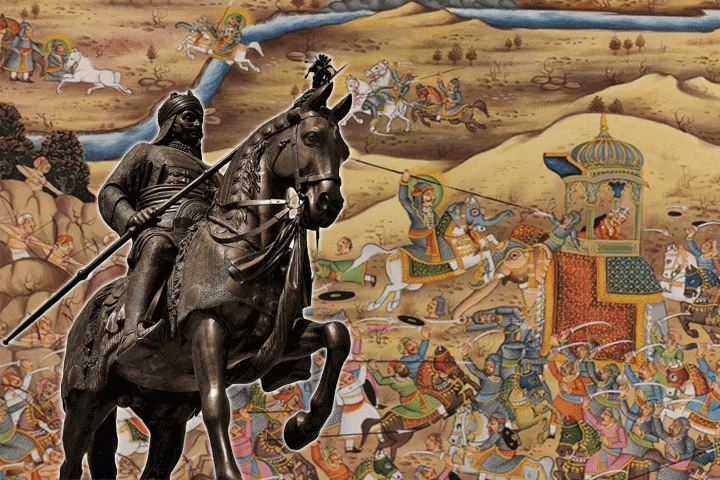Maharana Pratap, the inspiration of a brave ruler. He was one of the most rememorale rulers of Mewar, who has created an iconic place in the Indian History. Due to his unforgettable struggle for independence against the Mughal Empire and the determination he carries, he made an inspiring image for the upcoming generations for years. He was the revered ruler of Mewar, who was born in 1540 and became a king during a period of great unrest in the region. The local people he
re in Rajasthan consider this as synonymous with honor, courage and undefendable spirit. Under his leadership, Pratap faced the forced rule of the Mughal Empire, led by Emperor Akbar. The height of Maharna pratap was around 7 feet 5 inches, which reflects a massive and giant personality. Maharana Pratap’s height was noticeable in the accounts of History, which is a symbol of towering presence both leadership and even physically. But it is sad that it was just not his physical structure, what made him a historical man, it was his immersive bravery and unwavering determination for protecting his kingdom. While he was ruling the Mewar, one of the most iconic events occurred, “Battle of Haldighati”. The Battle of Haldighati was fought between the army of Akbar, the ruler of Mughal Empire and our inspiration Maharana Pratap. Although this battle was not a clear victory for Maharana Pratap, at the time of this battle, his courage and commitment won. This eventually became the source of eternal inspiration for several generations.
Early Life and Rise to Power
Maharana Pratap was born in the Kumbhalgarh fort in 1540. This was the time when the mughal empire was getting expanded to rule over India. He was the eldest son of Rana Udai Singh II and lived in an environment where leadership and the military was highly prioritized in royal life. His father trained him in several aspects of administration, governance and warfare, which enhanced its determination and courage to protect his land. At a young age Maharana Pratap was given the position of King due to his father’s abdication. In the year 1567, Akbar forcefully captured Chittorgarh Fort. Despite bothering about the challenges of Mughal forces, Pratap promised to never bow to foreign authority, which made him one of the most valiant struggles of India.
The Battle of Haldighati

In the year 1576, Maharnaa Pratap got engaged in the famous Battle of Haldighati, one of the most famous historical events in India. This battle was fought between the army of Mughal Empire and the great Maharana Pratap, which was led by Man Singh of Amer, who one of the trusted generals of Akbar. This battle was held on Haldighati, which made it a fiercely contested conflict. This event is not only memorable for the struggle faced by Maharana Pratap, but also because of his loyal horse. His horse, Chetak, also played a significant role at the time of the battle, by carrying the Maharana through the battle ground until it was wounded. Even as he died after ensuring the escape of Pratap, the bond between Chetak and Maharana Pratap became a symbol of loyalty.
Guerrilla Warfare and Resistance

After the battle of Haldighati, Maharana Pratap took on guerrilla warfare tactics for continuing his resistance against the mughal Empire. After realizing that he couldn’t defeat the Mughal due to his large number of resources, Pratap used the rocky and tough landscape of Mewar to win battles. To support him in his resilience for freedom, there were three loyal generals who acted as a pillar for him. Jhala Maan Singh, Hakim Singh, and Bhamashah not only got into the campaign of Pratap and also supported him financially at the time of his scarcity. This warfare kept the Mughal forces on edge and allowed Maharana Pratap to maintain the sovereignty of Mewar for years even after the battle. He then succeeded in guerrilla tactics and proved that smaller and less equipped armies can successfully resist more powerful invaders.
Legacy and Impact
The impact of his leadership transcended the battlefield. The refusal of Maharana Pratap to bow down to the Mughals became a symbol of dignity and self-respect for years in the continued generation. The life of this warrior reflects that true leadership is all about standing firm for the right and freedom. Maharana Pratap was not just a warrior for the Indians, but was a visionary who taught values of pride, freedom and resilience. The son of maharana pratap, Amar Singh I continued to uplift his legacy by assuring that his ideals were passed down through generations. His punyatithi is observed with great reminder of his sacrifices for his land and freedom. The strong efforts and legacy of Maharana Pratap reminds us about all the courage, love and determination for a land, which will also act as a significant inspiration for future generations.
The life of Maharana pratap was covered with resilience, valor nda unconditional loyalty for his people. From the age of 32, he became the king of Mewar and took over all the responsibilities. His role in the battle of Haldighati and his tactics in guerrilla warfare made his legacy lasting. In the current times his presence is preserved in Haldighati museum as an honor of respect. The combination of his love for Mewar and his determination remains an inspiration for all the indians.
FAQ
What was the most significant battle fought by Maharana Pratap?
The most significant battle fought by Maharana Pratap was the Battle of Haldighati. Despite being outnumbered, Pratap fiercely fought with Mughal forces, which reflects his courage and determination.
What were the key challenges faced by Maharana Pratap?
Maharana Pratap faced several challenges in his life such as the forced power of the Mughal Empire and the loss of Chittorgarh fort. Despite these obstacles, he was determined to protect his land and people
What is the significance of Chetak, Maharana Pratap’s horse?
Chetak, the horse of Maharana pratap is a huge symbol of loyalty as he carried him to a safe place from the place of battle despite being fatally wounded.
Who is the father of Maharana pratap?
Rana Udai Singh II, the ruler of Mewar, was the father of Maharana Pratap.




